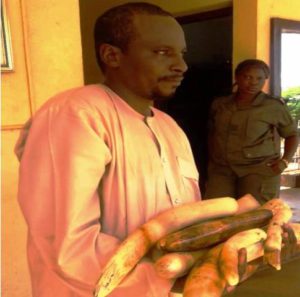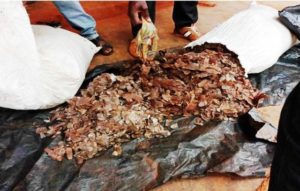B. Shancho Ndimuh
Several millions of plant and animal species are harvested every year from the wild as food, construction material, pets, medicine and for trade amongst others. Increasing demands for illegal wildlife products across Asia and other parts of the world, and the high profit from such products, continue to fuel excessive exploitation and illicit trade in wildlife, despite increasing fight from national and international conservation organisations. In Cameroon, illegal trade in wildlife products, corruption and other related wildlife crimes are becoming precarious and far reaching.

The Last Great Ape Organisation, Cameroon (LAGA) , in its 2018 annual report disclosed that up to 36 major wildlife traffickers were arrested and the sum of 321,095,000 F CFA (about $642,190) ordered to be paid as fines for wildlife crimes. The crimes included illegal possession of wildlife/wildlife products (including but not limited to, pangolin scales, ivory, and primates), and corruption.
Trafficking in Pangolin Scales
Despite a unanimous decision to ban all international trade in pangolins in 2016 by member countries of the International Trade in Endangered Species of Fauna and Flora (CITES), the illegal trade continue to take centre stage in most countries including Cameroon.

LAGA’s 2018 annual report has it that some six pangolin traffickers were arrested in Cameroon; three in Ambam, South Region with 80kg of pangolin scales, one in Betare Oya in the East Region, four in Santchou, West Region and three others in Doume with 35kg of pangolin scales. This report, is no doubt a pointer to the threats pangolins are exposed to in Cameroon. It also underscores the utmost need for concerted efforts and effective law enforcement to ameliorate the plight of this world’s most trafficked mammal in Cameroon.
Tusks Trafficking
Cameroon plays host to the African elephant, one of the mammals classified as vulnerable in the IUCN Red List. Despite ban on the international trade in ivory and the heavy penalty that awaits any one in unlawful possession of this species per the 1994 Cameroon Forestry and Wildlife Law, there is still an upsurge in African elephant poaching in Cameroon and illegal ivory trafficking.

LAGA, in her 2018 annual report gives a synopsis of illegal trade in ivory in Cameroon. One of such was a trafficker arrested, early 2018, in the East with 4 ivory tusks that was concealed in a truck ferrying cattle from the North to the East Region. Another ivory trafficking case captured in LAGA’s report took place in March, with two traffickers arrested in Ebolowa in the South Region in possession of four elephant tusks and a gun. The gun, according to the report, was provided by the widow of a senior police officer, who was also arrested.
In a related story, four traffickers were arrested in Santchou, West Region with an ivory tusk, elephant bones and pangolin scales. The four who arrived on bikes with bags of contraband were arrested as they were just about to illegally sell the products. This is a tip of the iceberg of the plight of elephants across the globe today. Statistics indicate that tens of thousands of elephants are killed every year for their tusk, with China being one of the biggest markets for such products.
Trade in Primates
As far as wildlife crimes pertaining to primates are concerned, LAGA reported that three traffickers were arrested with a live chimp and two mandrills in Ambam at the start of 2018. In April 2018, another primate trafficker was arrested with two live mandrills; a male and female, when he was just about to start breeding them for the black market. Four months after, one juvenile chimp concealed in a cardboard box was rescued in Douala. The trafficking of these primates is particularly disturbing and a pointer to the existence of a sophisticated network and market that needs to be identified and cracked down as soon as possible

.Corruption, Dangerous Maggot in Marrow of Wildlife Conservation in Cameroon
Corruption has proven beyond all reasonable doubts to be the maggots eating deep into the fabric of wildlife conservation and thwarting efforts aimed at conservation Cameroon’s emblematic species. Information from LAGA’s 2018 report indicates that corruption attempts were made to stop the prosecutorial process at early stages by offering bribes, peddling of influence and bringing pressure to bear on judicial officers. Several pangolin scales trafficking cases suffered from these attempts. “Wildlife and police officers simply took a bribe of 400 000 FCFA (about $800) along a highway to allow traffickers to continue their journey with pangolin scales. They traffickers were later arrested in Yaounde. Some of the corruption attempts were instantaneous targeting wildlife officials taking statements and writing complaint reports,” the report read in part.
Another story is told of a pangolin scales trafficker, whose family members mounted pressure offered a bribe as wildlife law enforcement officials were establishing the offence statement, but this was resisted with the help of LAGA. After the first corruption attempt was combated, the family again attempted to corrupt one of the substitutes of the prosecutor. The conviction was disappointing pointing to the possibility that the last corruption attempt succeeded as the trafficker was given a one-month imprisonment term contrary to the law that stipulates the punishment to be 1 to 3 years imprisonment.
One month later, another story is told how wildlife law enforcement officials received undue pressure from a traffickers’ daughter working at the regional delegation of MINFOF while establishing an offence statement during his arrest. After abortively bribing her colleagues, the trafficker’s daughter approached the LAGA team, to advance her agenda, to no avail. During the second case, those establishing the offence statement at the police station equally received high pressure from one of the suspect’s husband who is a colonel in the army. The enforcement officials, again, with help of LAGA resisted the traffic of influence.
Another prosecutorial process by LAGA that saw the face of corruption was during the arrest of some four traffickers in Santchou in the West Region for ivory trafficking. Here, it is reported that high profile traffic of influence came from an administrative official and a parliamentarian and from family members who piled pressure to illegally release the trafficker and this was combated by LAGA at the various levels.
.One other corruption attempt, according to the Report, filtered in September 2018, at the level of the Ngangue-Douala gendarmerie, where the accused gave FCFA 500,000 as bribe. This was followed by another bribe of FCFA 600,000 at Akwa South Brigade to the judicial officer so he could find a way to stop the matter at that level but the state counsel was already informed of the corruption in that case, the matter was forwarded to him. Again their attempts at corruption would continue at the prosecutorial level and they were released on bail.
Three months ago, another corruption case was reported in Douala. Here, ports gendarmerie arrested a man with 125kg of wildlife part as he attempted to smuggle the illicit cargo to Nigeria. Two accomplices arrived to bribe the gendarme officers and when the state counsel was informed of that, he ordered their arrest
Unlawful trade and undue exploitation of wildlife remain a major threat to endangered species. These illicit activities no doubt thwart the protection of Cameroon’s iconic wildlife species, depriving local communities and the country of their natural heritage. It is true the Cameroon Government has put in place good laws to combat illegal trade in wildlife species but the effective application of these laws still leave much to be desired. This has partly been attributed to limited enforcement mechanisms and mastery of procedures, and in adequate human and material resources to track down perpetrators and bring them to justice, most especially at the level of biodiversity hotspots and protected areas.








youre really a good webmaster. The website loading speed is incredible. It seems that you are doing any unique trick. In addition, The contents are masterpiece. youve done a fantastic job on this topic!